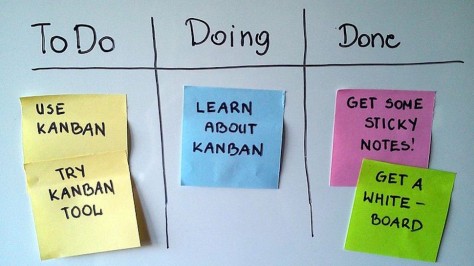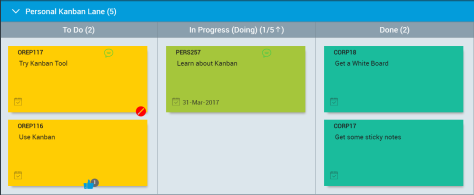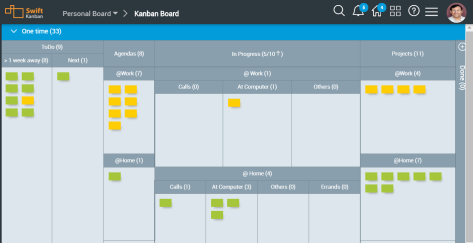Personal productivity and time management tools/methods have always been a subject of interest. Numerous methods and tools have been developed over the years. However, few seem to stick over time. Given that any tool or method needs a certain level of discipline at an individual level, is there a method that can really stick, help you manage better, visualize what you need to do and most importantly, stick? In this blog, I am going to share my own experience of tackling this challenge.
I got exposed to Lean thinking when we first started using the Kanban Method for our software development. That was about 8 years ago. Since then, I started using Kanban Boards, visualizing work, limiting the number of things on our plate, etc. It was a transformational experience.
A few years later, I came across Jim Benson’s adaptation of the he Kanban Method to personal productivity, called Personal Kanban. Personal Kanban adopted 2 principles from The Kanban Method. I will talk about in brief:
- Visualization
- Limiting Work-In-Progress(WIP)
1. Visualization does 2 things:
A) It lets you view your work items as a card, physical or electronic. Suddenly, an amorphous in-mind memory item becomes something that you can see, track (or even touch and feel, if its physical). In the picture below, you see a few examples of a person’s ToDo (“Use Kanban”, “Try Kanban Tool”, “Learn About Kanban”, “Get Some Sticky Notes” and “Get a White Board”).

(source: http://lifehacker.com/productivity-101-how-to-use-personal-kanban-to-vizuali-1687948640)
B) Put them on a board where you can track their progress. In the most simple form, the Board will comprise of a Backlog(ToDo) -> InProgress (Doing) -> Done. The picture above shows this in its simplest form.
We can use an Electronic Tool like (www.swiftkanban.com) to build a similar Board. An electronic tool can be used to indicate and track many other things. For example, I can add a Comment as I am progressing on the card, Block a card, raise a Risk/Issue, etc. Most importantly, being accessible on a mobile, my Personal Kanban system is always with me. If something comes to my mind when I am shopping in the mall, I can add it on the Board immediately, without having the burden of having to remember when I get back home! So, my electronic version of the above Personal Kanban board will look like this:

The next step is to create a “Next” lane (see below). Introducing a “Next” lane between Backlog and the In-Progress Lane helps focus on what I really need to work on. In the process, it consciously deprioritizes what I cannot work on now. That helps reset expectation with other people if I was supposed to get back to them. Unmet expectations, external or internal, are known to generate a lot of stress! So, just prioritization help bring down stress levels!

2. Limiting WIP: Contrary to the conventional thinking that multi-tasking is great, current behavioral science tells us otherwise. In fact, HBR says that multi-tasking brings down personal productivity by as much as 25-30%. Multi-tasking increases stress levels and people get burnt out. Defining a WIP limit, i.e., how many things we are going to work on at the same time, again helps us prioritize what we must do now. Once again, like the Next lane, it gives us a list of cards that we will NOT be working on and set expectations to myself/others.
So, where does GTD (Getting Things Done) fit in?
GTD helps us in “Getting” the prioritized card done. There are few key practices from the GTD body of knowledge that tremendously boost the effectiveness of Personal Kanban. We will discuss a couple of these below that I have found to be most useful:
- Mind-sweep: GTD strongly recommends clearing everything from the mind and moving to a system of our choice. The mind should be used to doing things; not trying to remember things. For a Personal Kanban user, the system of choice is our Personal Kanban system.
- Contextualize: GTD recommends contextualizing cards into buckets. Contextualization helps by clearly having a set of cards that we need to work on when we are in that context. In other words, we are not carrying the burden of full WIP always but ONLY what is in the context that we are in at the moment.
The two most elementary buckets are: “Work” and “Home”. Everything we do can be categorized into those two buckets. We go one level deeper. Almost all cards will have one of the following immediate actionable:
A) “Call” someone as the immediate next step.
B) You need a “Computer” to do the immediate next step on the card.
C) You need do an “Errand” for the immediate next step on the card.
D) You can add an “Others” bucket. I have it but rarely used it.
Categorize all our cards into one of these above buckets. These are your WIP and hence, should count towards your WIP limits.
However, in addition to the above, there are cards where the next actionable is not on us. We are waiting for an external event or a response from someone else, etc. For example, let’s say we need to get a new Passport. Once we have submitted the application, we are waiting for the Government to do a physical verification of the person by the police (at least, in India). You don’t want to mark it as done because it isn’t! Such a card, where the final outcome is pending and we need to track it till it is “really” done, is categorized under “Projects”. These cards are not part of your WIP. The next step is not with us. Such cards also fall under both Work and Home categories.
As a result, your Personal Kanban board will look something like this:

Once all the cards have been contextualized in different buckets, we have dramatically increased our focus when we are in any particular context. When we are at home in front of the computer, we know exactly what all needs to get done. When you are stepping out of home, you have a ready list of errands that you need to act upon.
I have also added one lane called “Agenda”. Here, I track any conversation that I need to be have with my directs at work or family members. So, I don’t need to store in my mind what I need to discuss with them! Remember, a free mind means more of the “mind” is focused on doing things – not remembering things.
As a result of applying Personal Kanban and GTD together, the “revised” Personal Kanban+GTD principles are:
- Visualize your work
- Prioritize by enforcing WIP limits on yourself.
- Contextualize your work
- De-stress by prioritizing – get back to people whose expectations might not be met!
- De-clutter your mind – use it to get things done; not remember things.
- TRUST your system of choice!
Last but not the least, use a mobile app to build your Personal Kanban so that you have it always with you. A recommendation would be SwiftKanban product, where I have my own Personal Kanban and from where some of the screenshots for this blog have been taken.
Happy Kanbanizing!

